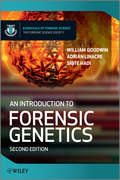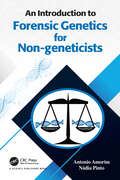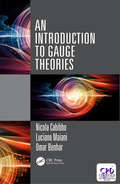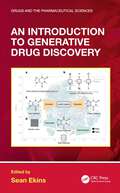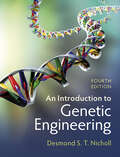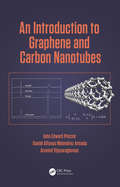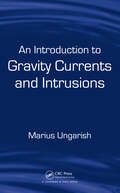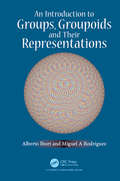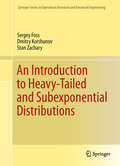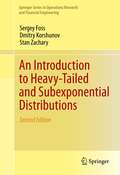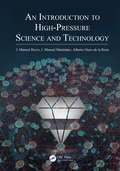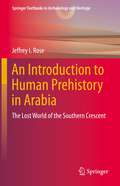- Table View
- List View
An Introduction to Forensic Genetics
by Adrian Linacre William Goodwin Sibte HadiThis is a completely revised edition of a comprehensive and popular introduction to the fast moving area of Forensic Genetics. The text begins with key concepts needed to fully appreciate the subject and moves on to examine the latest developments in the field. Now illustrated in full colour throughout, this accessible textbook includes numerous references to relevant casework. With information on the full process of DNA evidence from collection at the scene of a crime to presentation in a legal context this book provides a complete overview of the field.Key Features:Greater in-depth coverage of kinship problems now covered in two separate chapters: one dealing with relationships between living individuals and the other covering identification of human remains. New chapter on non-human forensic genetics, including identification of bacteria and viruses, animals and plants. Self assessment questions to aid student understanding throughout the text. Now with full colour illustrations throughout New companion website Accessible introduction to forensic genetics, from the collection of evidence to the presentation of evidence in a legal context. Included in the Forensic Science Society 'Essentials in Forensic Science' book series. This edition is to be included in the Forensic Science Society 'Essentials of Forensic Science' book series aimed at advanced level undergraduates and new practitioners to the field.
An Introduction to Forensic Genetics for Non-geneticists
by Antonio Amorim Nádia PintoThis book aims to enable non-experts in Genetics to understand the contribution of this science to resolve civil or criminal litigations, analysing evidence of human and non-human origins. The main difficulties in the comprehension and misuse of the results of Forensic Genetics reside in the lack of effective communication between geneticists and the users of the produced information (as lawyers and judges) and do not arise primarily from the lack of knowledge of genetics. Therefore, instead of a classical handbook we use a question-and-answer approach, which meets this interfacial essence. Questions that can be addressed by genetic expertise are typified and for each of them we provide the possible expert report, presenting the essential biological and statistical genetics background in the form of boxes/appendices, along with exemplary cases. Legal, ethical, and theoretical limitations of Forensic Genetics are discussed, formulating questions that cannot, or should not, be addressed by this applied science.
An Introduction to Gauge Theories
by Luciano Maiani Nicola Cabibbo Omar BenharWritten by world-leading experts in particle physics, this new book from Luciano Maiani and Omar Benhar, with contributions from the late Nicola Cabibbo, is based on Feynman’s path integrals. Key elements of gauge theories are described—Feynman diagrams, gauge-fixing, Faddeev-Popov ghosts—as well as renormalization in Quantum Electrodynamics. Quarks and QCD interactions are introduced. Renormalization group and high momentum behaviour of the coupling constants is discussed in QED and QCD, with asymptotic freedom derived at one-loop. These concepts are related to the Higgs boson and models of grand unification.
An Introduction to Generative Drug Discovery (Drugs and the Pharmaceutical Sciences)
by Sean EkinsThis book focuses on the latest advances in computational de novo drug discovery methods, also known as generative drug discovery. This book describes the state‑of‑the‑art methods and applications for de novo design of drug candidates using generative chemistry models as well as the ethical aspects of this technology. It will provide a foundation for those new to the field as well as those that may already have some experience of its utility. With contributions from scientists in both academia and industry ‘an Introduction to Generative Drug Discovery’ may represent one of the earliest if not the first book to focus on this topic. This book focuses on the latest advances in generative discovery methods. This book will describe different state of the art applications of generative molecule design. The book describes ethical aspects of generative drug discovery technology. The mix of academic and industrial authors provides an array of applications of generative drug discovery. A future perspective of where these generative technologies may take us in drug discovery is described included self-driving labs.
An Introduction to Genetic Engineering
by Desmond S. T. NichollIn this third edition of his popular undergraduate-level textbook, Des Nicholl recognises that a sound grasp of basic principles is vital in any introduction to genetic engineering. Therefore, as well as being thoroughly updated, the book also retains its focus on the fundamental principles used in gene manipulation. The text is divided into three sections: Part I provides an introduction to the relevant basic molecular biology; Part II, the methods used to manipulate genes; and Part III, applications of the technology. There is a new chapter devoted to the emerging importance of bioinformatics as a distinct discipline. Other additional features include text boxes, which highlight important aspects of topics discussed, and chapter summaries, which include aims and learning outcomes. These, along with key word listings, concept maps and a glossary, will enable students to tailor their study to suit their own learning styles and ultimately gain a firm grasp of a subject that students traditionally find difficult.
An Introduction to Genetic Engineering (Studies In Biology Ser.)
by Desmond S. NichollThe fourth edition of this popular textbook retains its focus on the fundamental principles of gene manipulation, providing an accessible and broad-based introduction to the subject for beginning undergraduate students. It has been brought thoroughly up to date with new chapters on the story of DNA and genome editing, and new sections on bioethics, significant developments in sequencing technology and structural, functional and comparative genomics and proteomics, and the impact of transgenic plants. In addition to chapter summaries, learning objectives, concept maps, glossary and key word lists the book now also features new concluding sections, further reading lists and web-search activities for each chapter to provide a comprehensive suite of learning resources to help students develop a flexible and critical approach to the study of genetic engineering.
An Introduction to Genetics for Language Scientists: Current concepts, methods and findings
by Dan DediuDuring the last few decades we have discovered enormous amounts about our genomes, their evolution and, importantly for linguists and language scientists, the genetic foundations of language and speech. Accessible and readable, this introduction is designed specifically for students and researchers working in language and linguistics. It carefully focuses on the most relevant concepts, methods and findings in the genetics of language and speech, and covers a wide range of topics such as heritability, the molecular mechanisms through which genes influence our language, and the evolutionary forces affecting them. Filling a large gap in the literature, this essential guide explores relevant examples including hearing loss, stuttering, dyslexia, brain growth and development, as well as the normal range of variation. It also contains a helpful glossary of terms, and a wide range of references so the reader can pursue topics of interest in more depth.
An Introduction to Graphene and Carbon Nanotubes
by John E. Proctor Daniel Melendrez Armada Aravind Vijayaraghavan<p>Carbon nanotubes and graphene have been the subject of intense scientific research since their relatively recent discoveries. This book introduces the reader to the science behind these rapidly developing fields, and covers both the fundamentals and latest advances. Uniquely, this book covers the topics in a pedagogical manner suitable for undergraduate students. The book also uses the simple systems of nanotubes and graphene as models to teach concepts such as molecular orbital theory, tight binding theory and the Laue treatment of diffraction. <p>Suitable for undergraduate students with a working knowledge of basic quantum mechanics, and for postgraduate researchers commencing their studies into the field, this book will equip the reader to critically evaluate the physical properties and potential for applications of graphene and carbon nanotubes.</p>
An Introduction to Gravity Currents and Intrusions
by Marius UngarishGravity currents and intrusions are the ubiquitous phenomena where a fluid of one density flows horizontally into a fluid of a different density. For researchers and engineers, the ability to understand and predict these flow fields is essential in wide-ranging applications including those involved with atmospheric and ocean dynamics, the propagati
An Introduction to Groups, Groupoids and Their Representations: An Introduction
by Alberto Ibort Miguel A. RodriguezThis book offers an introduction to the theory of groupoids and their representations encompassing the standard theory of groups. Using a categorical language, developed from simple examples, the theory of finite groupoids is shown to knit neatly with that of groups and their structure as well as that of their representations is described. The book comprises numerous examples and applications, including well-known games and puzzles, databases and physics applications. Key concepts have been presented using only basic notions so that it can be used both by students and researchers interested in the subject. Category theory is the natural language that is being used to develop the theory of groupoids. However, categorical presentations of mathematical subjects tend to become highly abstract very fast and out of reach of many potential users. To avoid this, foundations of the theory, starting with simple examples, have been developed and used to study the structure of finite groups and groupoids. The appropriate language and notions from category theory have been developed for students of mathematics and theoretical physics. The book presents the theory on the same level as the ordinary and elementary theories of finite groups and their representations, and provides a unified picture of the same. The structure of the algebra of finite groupoids is analysed, along with the classical theory of characters of their representations. Unnecessary complications in the formal presentation of the subject are avoided. The book offers an introduction to the language of category theory in the concrete setting of finite sets. It also shows how this perspective provides a common ground for various problems and applications, ranging from combinatorics, the topology of graphs, structure of databases and quantum physics.
An Introduction to Heavy-Tailed and Subexponential Distributions (Springer Series in Operations Research and Financial Engineering #38)
by Dmitry Korshunov Stan Zachary Sergey FossHeavy-tailed probability distributions are an important component in the modeling of many stochastic systems. They are frequently used to accurately model inputs and outputs of computer and data networks and service facilities such as call centers. They are an essential for describing risk processes in finance and also for insurance premia pricing, and such distributions occur naturally in models of epidemiological spread. The class includes distributions with power law tails such as the Pareto, as well as the lognormal and certain Weibull distributions.<P><P> This monograph defines the classes of long-tailed and subexponential distributions in one dimension and provides a complete and comprehensive description of their properties. New results are presented in a simple, coherent and systematic way. This leads to a comprehensive exposition of tail properties of sums of independent random variables whose distributions belong to the long-tailed and subexponential class.<P> The book includes a discussion of and references to contemporary areas of applications and also contains preliminary mathematical material which makes the book self contained. Modelers in the fields of finance, insurance, network science and environmental studies will find this book to be an essential reference.
An Introduction to Heavy-Tailed and Subexponential Distributions, 2nd Edition (Springer Series in Operations Research and Financial Engineering)
by Dmitry Korshunov Stan Zachary Sergey FossHeavy-tailed probability distributions are an important component in the modeling of many stochastic systems. They are frequently used to accurately model inputs and outputs of computer and data networks and service facilities such as call centers. They are an essential for describing risk processes in finance and also for insurance premia pricing, and such distributions occur naturally in models of epidemiological spread. The class includes distributions with power law tails such as the Pareto, as well as the lognormal and certain Weibull distributions.<P><P> One of the highlights of this new edition is that it includes problems at the end of each chapter. Chapter 5 is also updated to include interesting applications to queueing theory, risk, and branching processes. New results are presented in a simple, coherent and systematic way.<P> Graduate students as well as modelers in the fields of finance, insurance, network science and environmental studies will find this book to be an essential reference.
An Introduction to High-Pressure Science and Technology
by Alberto Otero de la Roza J. Manuel Recio J. Manuel MenéndezAn Introduction to High-Pressure Science and Technology provides you with an understanding of the connections between the different areas involved in the multidisciplinary science of high pressure. The book reflects the deep interdisciplinary nature of the field and its close relationship with industrial applications.Thirty-nine specialists in high
An Introduction to Human Prehistory in Arabia: The Lost World of the Southern Crescent (Springer Textbooks in Archaeology and Heritage)
by Jeffrey I. RoseThis textbook explores the mystery of human origins in the Arabian Peninsula, the lost Southern Crescent where humanity took its first steps toward civilization. Under Arabia’s surface of sand and stone lies a primordial realm of rolling grasslands, freshwater lakes, and river floodplains. This book aims to restore a critical missing chapter in the prehistory of our species that played out in this forgotten place of plenty. The author has carried out more than twenty years of fieldwork in Yemen and Oman, weaving his research together into an unorthodox tapestry of archaeology, environmental science, genetics, and Middle Eastern mythology. This volume peers beneath Arabia’s abandoned deserts, revealing a land that once served as a bridge between prehistoric worlds. This textbook is suitable for undergraduate and graduate students as well as all readers who are interested in learning about Arabian prehistory.
An Introduction to Human-Environment Geography
by William G. Moseley Holly M. Hapke Paul Laris Eric PerramondThis introductory level text explores various theoretical approaches to human-environment geography, demonstrating how local dynamics and global processes influence how we interact with our environments.Introduces students to fundamental concepts in environmental geography and scienceExplores the core theoretical traditions within the field, along with major thematic issues such as population, food and agriculture, and water resourcesOffers an engaging and unique view of the spatial relationships between humans and their environment across geographical locations around the worldIncludes a variety of real-world policy questions and emphasizes geography's strong tradition of field work by featuring prominent nature-society geographers in guest field notes
An Introduction to Inertial Confinement Fusion
by Susanne PfalznerNewcomers to the field of inertial confinement fusion (ICF) often have difficulty establishing a clear picture of the overall field. The reason for this is because, while there are many books devoted to special topics within the field, there is none that provides an overview of the field as a whole. An Introduction to Inertial Confinement Fusion fi
An Introduction to Information Science
by David Bawden Lyn RobinsonOffers an overview and outline of the important concepts and ideas in information science and librarianship. Among the critical topics covered: Foundations, including the information society, historical perspectives and concepts ; Organizing and retrieving information ; Information behavior and digital literacies ; Technologies and digital libraries ; Information research and methods ; Changing contexts including publishing, e-science and digital humanities ; The future of the profession.
An Introduction to Information Theory: Symbols, Signals and Noise
by John R. PierceBehind the familiar surfaces of the telephone, radio, and television lies a sophisticated and intriguing body of knowledge known as information theory. This is the theory that has permeated the rapid development of all sorts of communication, from color television to the clear transmission of photographs from the vicinity of Jupiter. Even more revolutionary progress is expected in the future.To give a solid introduction to this burgeoning field, J. R. Pierce has revised his well-received 1961 study of information theory for an up-to-date second edition. Beginning with the origins of the field, Dr. Pierce follows the brilliant formulations of Claude Shannon and describes such aspects of the subject as encoding and binary digits, entropy. language and meaning, efficient encoding , and the noisy channel. He then goes beyond the strict confines of the topic to explore the ways in which information theory relates to physics, cybernetics, psychology, and art. Mathematical formulas are introduced at the appropriate points for the benefit of serious students. A glossary of terms and an appendix on mathematical notation are provided to help the less mathematically sophisticated.J. R. Pierce worked for many years at the Bell Telephone Laboratories, where he became Director of Research in Communications Principles. He is currently affiliated with the engineering department of the California Institute of Technology. While his background is impeccable, Dr. Pierce also possesses an engaging writing style that makes his book all the more welcome. An Introduction to Information Theory continues to be the most impressive non-technical account available and a fascinating introduction to the subject for laymen."An uncommonly good study. . . . Pierce's volume presents the most satisfying discussion to be found."- Scientific American.
An Introduction to Integrable Techniques for One-Dimensional Quantum Systems (Lecture Notes in Physics #940)
by Fabio FranchiniThis book introduces the reader to basic notions of integrable techniques for one-dimensional quantum systems. In a pedagogical way, a few examples of exactly solvable models are worked out to go from the coordinate approach to the Algebraic Bethe Ansatz, with some discussion on the finite temperature thermodynamics. The aim is to provide the instruments to approach more advanced books or to allow for a critical reading of research articles and the extraction of useful information from them. We describe the solution of the anisotropic XY spin chain; of the Lieb-Liniger model of bosons with contact interaction at zero and finite temperature; and of the XXZ spin chain, first in the coordinate and then in the algebraic approach. To establish the connection between the latter and the solution of two dimensional classical models, we also introduce and solve the 6-vertex model. Finally, the low energy physics of these integrable models is mapped into the corresponding conformal field theory. Through its style and the choice of topics, this book tries to touch all fundamental ideas behind integrability and is meant for students and researchers interested either in an introduction to later delve in the advance aspects of Bethe Ansatz or in an overview of the topic for broadening their culture.
An Introduction to Interdisciplinary Research: 2nd Revised Edition (Perspectives on Inter- and Transdisciplinarity)
by Machiel Keestra Anne Uilhoorn Jelle ZandveldWe are increasingly realizing that, as a result of technological developments and globalization, problems are becoming so complex that they can only be solved through cooperation between scientists from different disciplines. Healthcare, climate change, food security, globalization, and quality of life are just a few examples of issues that require scientists to work across disciplines. In many cases, extra-academic stakeholders must be involved in order to arrive at robust solutions. Young academics are being called on to step beyond the boundaries of traditional disciplines to contribute to addressing fundamental, often societal problems. As a result of these developments, an interdisciplinary approach is becoming increasingly necessary and popular in higher education. Students need to learn more about how to integrate and apply knowledge, methods, and skills from different fields. The crucial step of integration within interdisciplinary research is treated extensively in this textbook, which contains a comprehensive ‘interdisciplinary integration toolbox’. In addition, students must learn to collaborate in teams. An Introduction to Interdisciplinary Research serves as a systematic manual to guide students through this interdisciplinary research process.
An Introduction to KMS Weights (Lecture Notes in Mathematics #2362)
by Klaus Erik ThomsenThis book provides an introduction to the theory of KMS weights and KMS states, which play an important role in mathematical physics and other applications of operator algebras. Leading from the definitions to some of the most recent research results, it covers advanced topics such as the Laca-Neshveyev theorem, elements of the modular theory of von Neumann algebras, the geometry of the set of KMS weights, duality (for KMS weights on crossed products), the relationship between KMS weights and traces and the types of factors associated with extremal KMS weights. Some of the material is new, in the sense that the proofs and results are published here for the first time. This relatively self-contained book will be useful both to researchers in the area of operator algebras and to more advanced students who wish to enter this field.
An Introduction to Kinetic Monte Carlo Simulations of Surface Reactions (Lecture Notes in Physics #856)
by A.P.J. JansenKinetic Monte Carlo (kMC) simulations still represent a quite new area of research, with a rapidly growing number of publications. Broadly speaking, kMC can be applied to any system describable as a set of minima of a potential-energy surface, the evolution of which will then be regarded as hops from one minimum to a neighboring one. The hops in kMC are modeled as stochastic processes and the algorithms use random numbers to determine at which times the hops occur and to which neighboring minimum they go. Sometimes this approach is also called dynamic MC or Stochastic Simulation Algorithm, in particular when it is applied to solving macroscopic rate equations. This book has two objectives. First, it is a primer on the kMC method (predominantly using the lattice-gas model) and thus much of the book will also be useful for applications other than to surface reactions. Second, it is intended to teach the reader what can be learned from kMC simulations of surface reaction kinetics. With these goals in mind, the present text is conceived as a self-contained introduction for students and non-specialist researchers alike who are interested in entering the field and learning about the topic from scratch.
An Introduction to Large-Scale Tropical Meteorology (Springer Atmospheric Sciences)
by Vasubandhu MisraThis upper-undergraduate/graduate-level textbook introduces students to large-scale tropical climate circulation and its variations, covering their fundamental aspects and our current understanding of how they are impacted in a warming world. From this volume, readers will gain an understanding of tropical climate variability from the meso- to planetary scale. Uniquely, equal emphasis is placed on atmospheric and oceanic processes of tropical phenomena. The book will appeal to senior undergraduate and graduate students across geoscience disciplines, including in meteorology, oceanography, geography, hydrology, and environmental science.
An Introduction to Lieb's Simplified Approach to the Bose Gas (SpringerBriefs in Physics)
by Ian JauslinThis book explores Lieb's Simplified approach to the ground state of systems of interacting bosons. While extensive research has delved into the behavior of interacting bosons, persistent challenges, such as proving Bose-Einstein condensation, remain. Introduced by Lieb in 1963, the Simplified approach has been the object of renewed attention in recent years, revealing surprising and promising results. Notably, this approach provides ground state energy predictions that agree with many-body systems asymptotically at both low and high densities. It further predicts a condensate fraction and correlation function that agree with Bogolyubov theory at low densities, and numerical predictions match quantum Monte Carlo simulations across all densities. This suggests that Lieb's Simplified approach could serve as a potent tool for reimagining the study of interacting bosons. The book defines Lieb's Simplified approach, discusses its predictions, and presents known analytical and numerical results. It is designed for advanced students and young researchers working in the fields of mathematical physics, quantum many-body physics and Bose-Einstein condensates.
An Introduction to Lightning
by Vernon CoorayThis book about lightning summarizes the essence of physics and effects of lightning in a non-technical manner and provides an up-to-date description of the phenomenon of lightning in simple language. Starting with the myths related to lightning, the reader is introduced to the mechanism of lightning flashes and their interactions with humans, human-made systems and Earth's environment. Most of the available books on lightning are written for the experts in the field and there is a need for a book that introduces the undergraduate and beginning post graduate students to the subject of lightning and prepares them for more advanced books meant for the experts. This introductory book, which is based on a series of lectures given to undergraduate and postgraduate students in electrical engineering, is intended to fill this need. Tailored to the needs of university students who plan to study electrical engineering, meteorology, environmental or basic physics, it is also a valuable reference resource for laymen who are interested in knowing more on this phenomenon.
